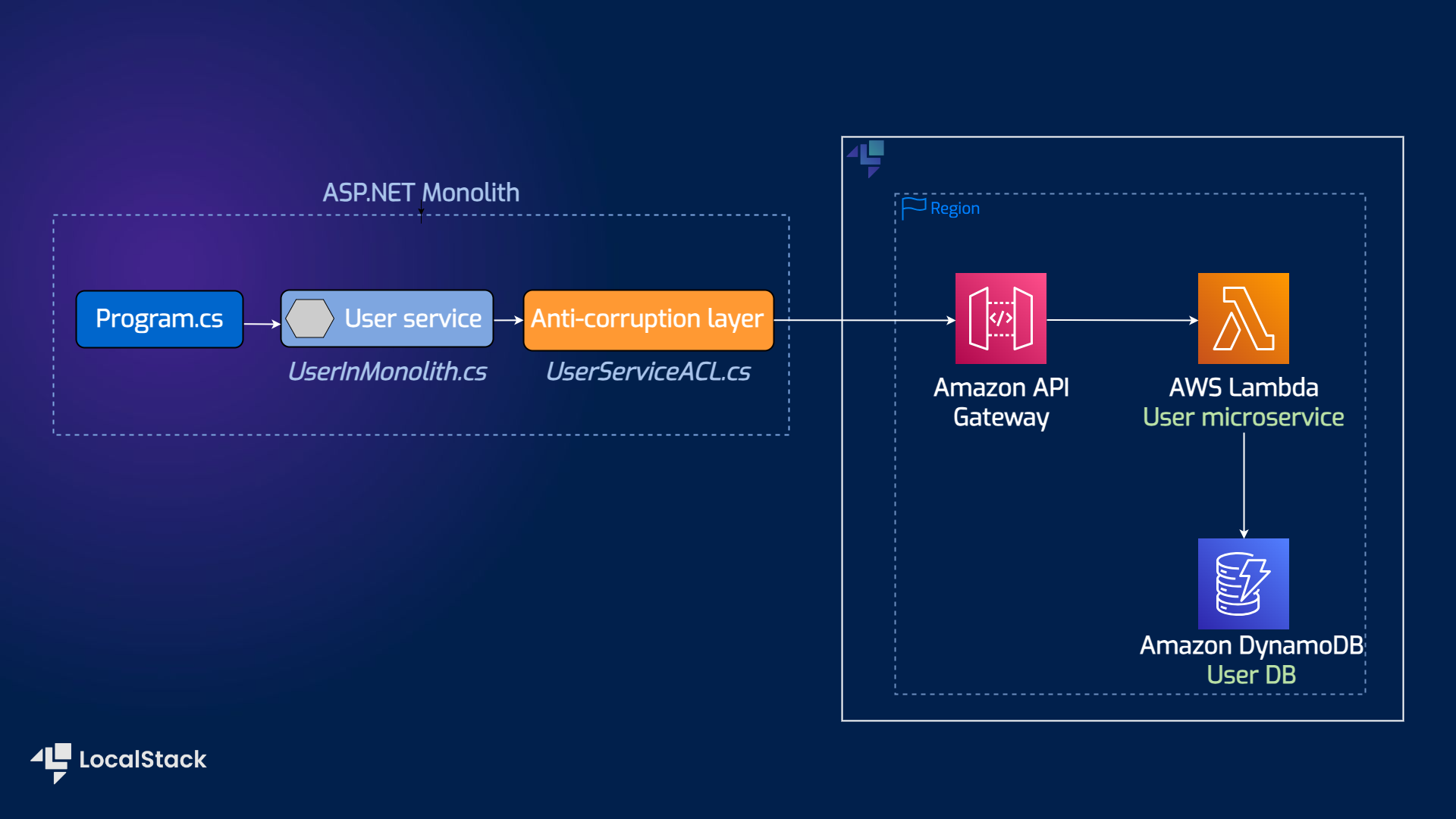| Key | Value |
|---|---|
| Environment |   |
| Services | API Gateway, DynamoDB, Lambda |
| Integrations | CDK |
| Categories | Serverless; Microservices; Software Architecture |
| Level | Intermediate |
| GitHub | Repository link |
The sample application implements an Anti-Corruption Layer (ACL) pattern to act as a mediation layer that translates the domain model semantics from one system to another system. It translates the upstream bounded context’s (monolith) model into one that suits the downstream bounded context (microservice) before consuming the communication contract established by the upstream team.
In this sample application, a user microservice has been strangled out of the ASP.NET monolith application. The user microservice has been deployed as a Lambda function on AWS and calls to the Lambda function are routed through an API Gateway. An anti-corruption layer has been deployed in the monolith that translates the call to adapt to the semantics of the user microservice.
Users can deploy this application on LocalStack and AWS with no changes using Cloud Development Kit (CDK). To test this application sample, we will demonstrate how you use LocalStack to deploy the infrastructure on your developer machine and your CI environment.
The following diagram shows the architecture that this sample application builds and deploys:
We are using the following AWS services and their features to build our infrastructure:
- DynamoDB to store the user data for the user microservice implementation.
- API Gateway to expose the user microservice implementation as a REST API.
- Lambda to host the user microservice implementation, exposed via API Gateway.
- LocalStack Pro with the
localstackCLI. - Cloud Development Kit with the
cdklocalinstalled. - .NET Core 7.0 or later and .NET Core Global Tools for AWS
Start the LocalStack Pro container via the following command:
export LOCALSTACK_AUTH_TOKEN=<YOUR_AUTH_TOKEN>
DEBUG=1 localstack startWe specified DEBUG=1 to get the printed LocalStack logs directly in the terminal to help us visualize the background tasks in action. If you prefer running LocalStack in detached mode, you can add the -d flag to the localstack start command, and use Docker Desktop to view the logs.
The Lambda functions in the user-microservice-lambda directory should be packaged and copied to the cdk-user-microservice/lambdas directory before deploying them using CDK. You can run these commands to process the UserMicroserviceLambda function:
cd user-microservice-lambda/src/UserMicroserviceLambda
dotnet lambda package
mkdir -p ../../../cdk-user-microservice/lambdas
cp bin/Release/net6.0/UserMicroserviceLambda.zip ../../../cdk-user-microservice/lambdas
cd ../../..To create the AWS infrastructure locally, you can use CDK and cdklocal wrapper. To deploy the infrastructure, you can run the following commands:
cd cdk-user-microservice/src/CdkUserMicroservice && dotnet build
cd ../..
cdklocal bootstrap
cdklocal deployThis will deploy the CdkUserMicroserviceStack stack on LocalStack. You will see the following output:
✅ CdkUserMicroserviceStack
✨ Deployment time: 15.55s
Outputs:
CdkUserMicroserviceStack.MicroserviceAPIEndpointE7B12008 = https://bn2bzt4beb.execute-api.localhost.localstack.cloud:4566/prod/
Stack ARN:
arn:aws:cloudformation:us-east-1:000000000000:stack/CdkUserMicroserviceStack/7a2ad8e4
✨ Total time: 22.43sThe output will show the API Gateway URL endpoint to be used for testing. You will see a different URL endpoint in your output, and you can save it for later use.
You can use the following command to send a test event to the API Gateway:
cd ..
cd anti-corruption-layer-impl && dotnet build
API_ENDPOINT=<your-api-endpoint-returned-by-cdk-output>
curl -X POST $API_ENDPOINT/user -H "Content-Type: application/json" -d '{"UserId": 12345, "Address": "475 Sansome St,10th floor","City": "San Francisco","State": "California","ZipCode": 94111,"Country": "United States"}'Change the URL endpoint with the one you received in the CDK output. You will see the following response:
{"statusCode":200,"headers":{"Content-Type":"application/json","Access-Control-Allow-Origin":"*"},"body":"Processed","isBase64Encoded":false} This application sample hosts an example GitHub Action workflow that starts up LocalStack, builds the Lambda functions, and deploys the infrastructure on the runner. You can find the workflow in the .github/workflows/main.yml file. To run the workflow, you can fork this repository and push a commit to the main branch.
Users can adapt this example workflow to run in their own CI environment. LocalStack supports various CI environments, including GitHub Actions, CircleCI, Jenkins, Travis CI, and more. You can find more information about the CI integration in the LocalStack documentation.
We appreciate your interest in contributing to our project and are always looking for new ways to improve the developer experience. We welcome feedback, bug reports, and even feature ideas from the community. Refer to the contributing guide for more details on how to get started.
